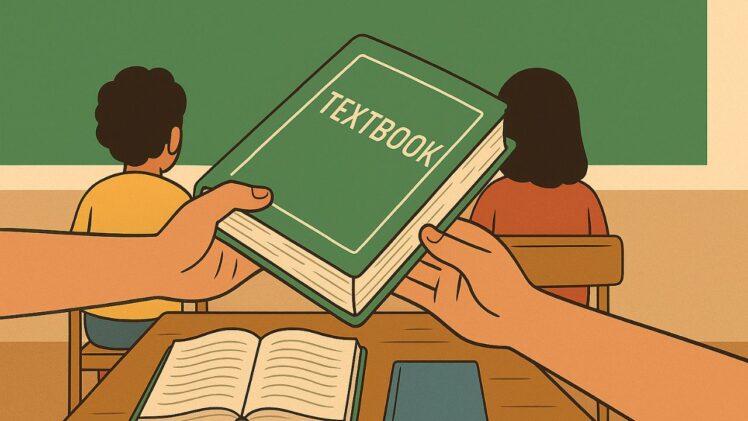
Shillong, Meghalaya — For a parent already burdened by mounting medical expenses within the family, the start of the academic year brought with it a cruel twist. When she approached her child’s school with a simple request — could her child reuse textbooks from the previous batch, just like hand-me-down clothes — the answer was an emphatic NO.
“The new books are different,” she was assured by the school’s administration. With little choice, she scraped together her meagre savings and bought the entire new set.
Days later, after carefully turning each page and comparing the books, she discovered what she had suspected all along: the new books were virtually identical to the previous year’s editions — same chapters, same layout, even the same exercises. Only the covers had changed.
The extra money she spent — which could have gone toward critical medicines or doctor’s appointments — was wasted. And this is not an isolated story. I don’t know how this story ended but it provokes me enough to delve into this topic a little more. It gains even greater significance against the backdrop of a recent study that found the monthly income of households in 25 out of 39 blocks in Meghalaya is less than Rs.5000.
Across the country, millions of families face similar heartbreaks, navigating the pressures of school requirements while juggling essential household needs. In a time where inflation and uncertainty have made every rupee count, even the smallest savings could mean the difference between treatment and neglect, meals and hunger, or education and dropout. And it brings back from the ashes, a simple principle and practice of REUSE into the school vocabulary in relations to books.
This incident raises a fundamental question: Can our education system afford to ignore the potential of a hand-me-down textbook policy?
It is not a foreign concept as generations / families in Shillong have practised this casually over the years handing down books to friends and families. But let us delve into this a little further in this article.
The Indian book publishing industry, with educational publishing (including schoolbooks) comprising over 90% of the market, was valued at approximately 8.8 billion dollars in 2019-2020, projected to reach 12 billion dollars by 2024. Schoolbooks alone accounted for 71% of this market, roughly 6.25 billion dollars in 2019-2020.
The Northeast, with a population of about 45 million (3-4% of India’s total), has a smaller but growing educational sector. Assuming proportional market share, the schoolbooks market in Northeast India might be estimated at 200–300 million dollars annually. However, this is a rough estimate, as the region has lower per capita income and fewer private schools (0.384 million private schools nationally, with Northeast having a smaller share).
Annual Changes in the Schoolbooks Industry
The schoolbooks industry in India does not change dramatically every year but shows consistent growth with some fluctuations:
The KG-12 books market was projected to grow at a compound annual growth rate (CAGR) of 19.6% from 2014-15 to 2019-20, driven by rising literacy rates and school retention. Recent data suggests a 10% annual growth in book production volume in the National Capital Region, with similar trends likely in the Northeast due to increasing school enrolment.
The National Council of Educational Research and Training (NCERT) and state boards periodically revise curricula, necessitating new editions. This can cause spikes in demand but not dramatic annual shifts unless major policy changes occur (e.g., National Education Policy 2020 implementation).
Post-pandemic challenges like paper price hikes (from Rs 60 to Rs 110 per kg) and transport costs have increased production costs, potentially stabilizing or slightly reducing output in some years. Piracy and digital adoption (70% of publishers digitize content) also temper physical book market growth.
In the Northeast, growth is likely steady but moderated by economic constraints and reliance on government textbook programs.
ALSO READ:
AEEE Launches VICALP Project in Shillong with aim to decarbonize Shillong’s building sector
Building a Greener Shillong: Stakeholders Unite for Low-Carbon Construction Practices
How local youth can become key actors in biodiversity conservation
Environmental Impact
We need to turn our attention to the Environmental Impact of Printing New Books Annually as printing new schoolbooks annually has a significant environmental footprint:
– Paper Consumption: Globally, book publishing consumes millions of trees annually. In India, producing 3 billion schoolbooks (estimated total, including state and private publishers) requires approximately 30 million trees, assuming one tree produces 100 books (600g per book, 59kg paper per tree).
– Carbon Emissions: Paper production emits over 0.5 tonnes of CO2e per tonne of paper. For 3 billion books (assuming 1.8 million tonnes of paper), this translates to roughly 900,000 tonnes of CO2e annually. Printing processes add volatile organic compound (VOC) emissions from inks and solvents.
– Transportation: Books are transported across India, often by truck or air, adding emissions. For instance, air transport for a single book can equal its production emissions.
– Waste: Unsold or outdated books contribute to waste. Globally, 320 million books are discarded annually, with India likely contributing significantly due to overprinting and piracy.
– Northeast Context: The Northeast’s smaller market may contribute proportionally less (e.g., 1–2 million trees cut, 30,000–50,000 tonnes CO2e), but its remote geography increases transport emissions. Local printing is limited, so books are often shipped from Delhi or Kolkata.
Feasibility of a Government Hand-Me-Down Policy for Schoolbooks
There is no shame in reuse — our society has always embraced it. Hand-me-downs were once a mark of sustainability, not inadequacy. In fact, reusing textbooks is an idea whose time has come — again. We see a thriving thrift market emerging after the pandemic and that can be adopted for the educational book sector.
A hand-me-down policy, where schoolbooks are reused by passing them from one student to the next, could reduce environmental impact. Its feasibility and potential in India, particularly the Northeast, depends on several factors:
Benefits
– Environmental Savings:
– Reduced Paper Use: Reusing books could cut demand for new prints by 30–50%, saving millions of trees and reducing CO2e emissions by hundreds of thousands of tonnes annually.
– Lower Waste: Fewer unsold or discarded books would reduce landfill waste (e.g., 640,000 tons globally).
– Transport Savings: Less frequent printing and distribution would lower transport emissions.
– Cost Savings: Government and families could save significantly. NCERT books are subsidized, but private schoolbooks cost families Rs 2,000–5,000 per year. Reusing books could halve these costs.
– Educational Access: Poorer households in the Northeast, where affordability is a barrier, would benefit from free or low-cost reused books.
What are we truly aiming for?
The Pursuit of Learning Outcomes
The goal of every educational institution, should be the successful achievement of the Learning Outcomes through the clearly defined understanding and application of the knowledge, skills and abilities of the student based on a standardized benchmark. While books may provide a foundation, they are not the sole means of achieving the learning outcomes. The abilities, methodology and communication of concepts, models and real-world application facilitated by the teachers play a key role in the process. So, if the books are similar in nature, then why do we pressure parents to keep buying new books that could have been handed down from seniors to their juniors? For all I care, you could have a complete public relations spin done on this to showcase the change at the school level.
Support Schemes and their pitfalls
There will always be the voices that bellow the oft-repeated phrase: ‘there are schemes for the less fortunate, so tell them to apply for them. The rest of us can buy the books’. Schemes work to an extent; to alleviate the financial burdens of parents but we are also wary of schemes for the simple reason that the benefits might turn up in your bank account when you are nearing the grave. It has always been a case of too little, too late. Why should a scheme be the solution when there is an easier alternative that is grounded in the institution and can be easily monitored at the local level with little or no operational expenses. Just a policy statement and directive would serve us nicely. And I am sure that every family is happier when it is saving a little more.
The What-If Strategies
– Pilot Programs: Start with government schools in the Northeast, where NBT and Samagra Shiksha Abhiyan already operate, to test logistics. We could adopt 5-10 schools in each district with guidelines and good practices for students and parents for ensuring the longevity of the books such as no scribbling in the textbooks, use of books covers, book maintenance, etc
– Curriculum Stabilization: Limit syllabus changes to every 5–7 years to maximize book reuse. Most state education boards can manage this at the local level. For other boards, it can be internally arranged as buying books is not a legal obligation, possessing them is a requirement.
– Community Engagement: Promote book donation drives and local book banks, leveraging Northeast’s community-oriented culture including the Dorbars, parents and alumni.
– To ensure that it is not a total loss of the first generation of ‘purchasing parents’, the second generation of ‘purchasing parents’ can pay a fee of 45% of the original cost of the book to the previous generation. An additional facilitating fee of 5% can be levied by the school with properly accounted for receipts and audits. And so on and so forth. It may not be the best solution but it is better than no solution at all. These are thinking-out-loud ideas that may need further churning before implementing.
Unfortunately, behind the insistence on “new” textbooks is a darker, often unspoken practice — the commissions. Many publishers offer schools a commission for selecting and promoting their books. These financial incentives, though rarely disclosed, can influence school decisions, ultimately burdening parents with unnecessary costs. (Deeper delving in another article)
Conclusion
A hand-me-down policy is feasible and could save millions of trees and tonnes of CO2e while reducing costs. Piloting in government schools, stabilizing curricula, and integrating digital solutions could make it viable, especially in the Northeast’s resource-constrained context.
Parents and teachers alike must ask: Are textbooks being chosen based on educational value, or on commercial gains?
A responsible, child-centric educational model must factor in the real-life challenges that families face. A structured hand-me-down policy, supported by schools and perhaps even aided by local NGOs, could significantly reduce the financial load on parents. Moreover, a system of rotating books across batches can instil values of sharing, care, and sustainability in students.
Schools exist to educate — not to market. And in the effort to raise a generation of informed, empathetic citizens, this simple change in textbook policy could go a long way. So can the Education department, Government of Meghalaya set a trend in being eco-friendly, environmentally conscious and promote a practice of hand-me-down books policy and directive in the schools? Maybe it is time to regulate the schoolbooks from an economic & eco-friendly standpoint in the same way that the Tamil Nadu government has been doing since promoting Book Banks at the school level. Sometimes, becoming a smarter state does not always mean spending more money. Saving money can be a blessing in disguise for many parents in the education system.
And sometimes, turning the same old page is better — especially when it can help heal a home.







